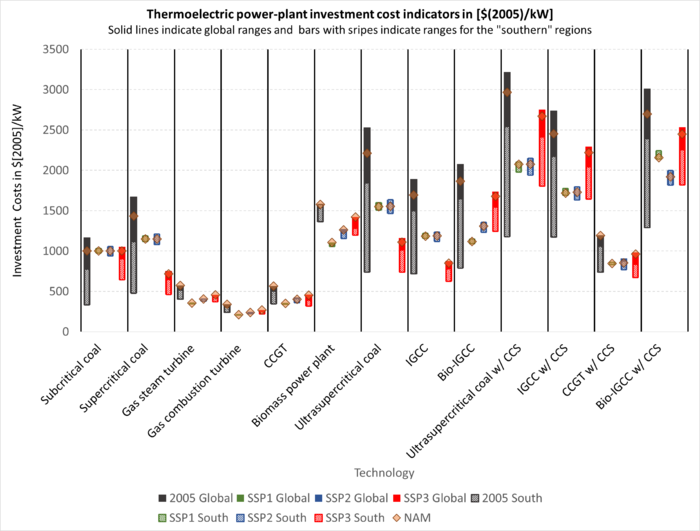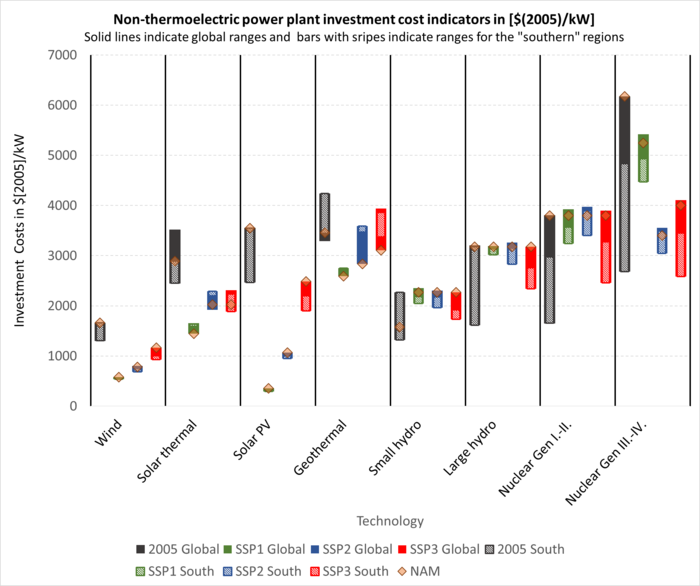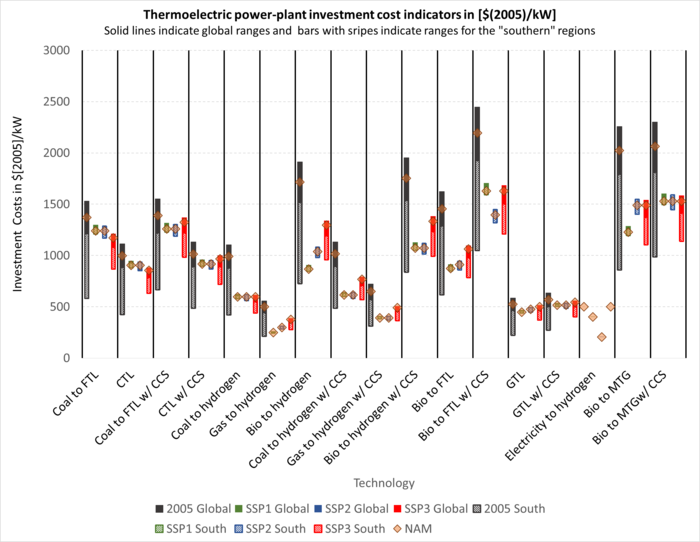Energy conversion - MESSAGE-GLOBIOM
| Corresponding documentation | |
|---|---|
| Previous versions | |
| Model information | |
| Model link | |
| Institution | International Institute for Applied Systems Analysis (IIASA), Austria, http://data.ene.iiasa.ac.at. |
| Solution concept | General equilibrium (closed economy) |
| Solution method | Optimization |
| Anticipation | |
Energy technologies are characterized by numerical model inputs describing their economic (e.g., investment costs, fixed and variable operation and maintenance costs), technical (e.g., conversion efficiencies), ecological (e.g., GHG and pollutant emissions), and sociopolitical characteristics. An example for the sociopolitical situation in a world region would be the decision by a country or world region to ban certain types of power plants (e.g., nuclear plants). Model input data reflecting this situation would be upper bounds of zero for these technologies or, equivalently, their omission from the data set for this region altogether.
Each energy conversion technology is characterized in MESSAGE by the following data:
- Energy inputs and outputs together with the respective conversion efficiencies. Most energy conversion technologies have one energy input and one output and thereby one associated efficiency. But technologies may also use different fuels (either jointly or alternatively), may have different operation modes and different outputs, which also may have varying shares. An example of different operation modes would be a passout turbine, which can generate electricity and heat at the same time when operated in co-generation mode or which can produce electricity only. For each technology, one output and one input are defined as main output and main input respectively. The activity variables of technologies are given in the units of the main input consumed by the technology or, if there is no explicit input (as for solar-energy conversion technologies), in units of the main output.
- Specific investment costs (e. g., per kilowatt, kW) and time of construction as well as distribution of capital costs over construction time.
- Fixed operating and maintenance costs (per unit of capacity, e.g., per kW).
- Variable operating costs (per unit of output, e.g. per kilowatt-hour, kWh, excluding fuel costs).
- Plant availability or maximum utilization time per year. This parameter also reflects maintenance periods and other technological limitations that prevent the continuous operation of the technology.
- Technical lifetime of the conversion technology in years.
- Year of first commercial availability and last year of commercial availability of the technology.
- Consumption or production of certain materials (e.g. emissions of kg of CO2 or SO2 per produced kWh).
- Limitations on the (annual) activity and on the installed capacity of a technology.
- Constraints on the rate of growth or decrease of the annually new installed capacity and on the growth or decrease of the activity of a technology.
- Technical application constraints, e.g., maximum possible shares of wind or solar power in an electricity network without storage capabilities.
- Inventory upon startup and shutdown, e.g., initial nuclear core needed at the startup of a nuclear power plant.
- Lag time between input and output of the technology.
- Minimum unit size, e.g. for nuclear power plants it does not make sense to build plants with a capacity of a few kilowatt power (optional, not used in current model version).
- Sociopolitical constraints, e.g., ban of nuclear power plants, or inconvenience costs of household cook stoves.
- Inconvenience costs which are specified only for end-use technologies (e.g. cook stoves)
The specific technologies represented in various parts of the energy conversion sector are discussed in the following sections on Electricity, Heat, Other conversion, and ref:`grid` below.
Electricity
MESSAGE covers a large number of electricity generation options utilizing a wide range of primary energy sources. For fossil-based electricity generation technologies, typically a number of different technologies with different efficiencies, environmental characteristics and costs is represented. For example, in the case of coal, MESSAGE distinguishes subcritical and supercritical pulverized coal (PC) power plants where the subcritical variant is available with and without flue gas desulpherization/denox and one internal gasification combined cycle (IGCC) power plant. The superciritical PC and IGCC plants are also available with carbon capture and storage (CCS) which also can be retrofitted to some of the existing PC power plants. <xr id="tab:MESSAGE-GLOBIOM_elec"/> below shows the different power plant types represented in MESSAGE.
Four different nuclear power plant types are represented in MESSAGE-GLOBIOM, i.e. two light water reactor types, a fast breeder reactor and a high temperature reactor, but only the two light water types are included in the majority of scenarios being developed with MESSAGE in the recent past. In addition, MESSAGE includes a representation of the nuclear fuel cycle, including reprocessing and the plutonium fuel cycle, and keeps track of the amounts of nuclear waste being produced.
The conversion of five renewable energy sources to electricity is represented in MESSAGE-GLOBIOM (see <xr id="tab:MESSAGE-GLOBIOM_elec"/>). For wind power, both on- and offshore electricity generation are covered and for solar energy, photovoltaics (PV) and solar thermal (concentrating solar power, CSP) electricity generation are included in MESSAGE (see also sections on Non-biomass renewables of MESSAGE-GLOBIOM and :ref:syst_integration).
Most thermal power plants offer the option of coupled heat production (CHP, see <xr id="tab:MESSAGE-GLOBIOM_elec"/>). This option is modeled as a passout turbine via a penalty on the electricity generation efficiency. In addition to the main electricity generation technologies described in this section, also the co-generation of electricity in conversion technologies primarily devoted to producing non-electric energy carriers (e.g., synthetic liquid fuels) is included in MESSAGE (see section on :ref:other).
<figtable id="tab:MESSAGE-GLOBIOM_elec">
| Energy source | Technology | CHP option |
|---|---|---|
| Coal | subcritical PC power plant without desulphurization/denox | yes |
| subcritical PC power plant with desulphurization/denox | yes | |
| supercritical PC power plant with desulphurization/denox | yes | |
| supercritical PC power plant with desulphurization/denox and CCS | yes | |
| IGCC power plant | yes | |
| IGCC power plant with CCS | yes | |
| Oil | heavy fuel oil steam power plant | yes |
| light fuel oil steam power plant | yes | |
| light fuel oil combined cycle power plant | yes | |
| Gas | gas steam power plant | yes |
| gas combustion turbine gas | yes | |
| combined cycle power plant | yes | |
| Nuclear | nuclear light water reactor (Gen II) | yes |
| nuclear light water reactor (Gen III+) | yes | |
| fast breeder reactor | ||
| high temperature reactor | ||
| Biomass | biomass steam power plant | yes |
| biomass IGCC power plant | yes | |
| biomass IGCC power plant with CCS | yes | |
| Hydro | hydro power plant (2 cost categories) | no |
| Wind | onshore wind turbine | no |
| offshore wind turbine | no | |
| Solar | solar photovoltaics (PV) | no |
| concentrating solar power (CSP) | ||
| Geothermal | geothermal power plant | yes |
</figtable>
Technological change in MESSAGE is generally treated exogenously, although pioneering work on the endogenization of technological change in energy-engineering type models has been done with MESSAGE (Messner, 1997 MSG-GLB_messner_endogenized_1997). The current cost and performance parameters, including conversion efficiencies and emission coefficients is generally derived from the relevant engineering literature. For the future alternative cost and performance projections are usually developed to cover a relatively wide range of uncertainties that influences model results to a good extent. As an example, <xr id="fig:MESSAGE-GLOBIOM_ther"/> and <xr id="fig:MESSAGE-GLOBIOM_nonth"/> below provide an overview of costs ranges for a set of key energy conversion technologies (Fricko et al., 2016 MSG-GLB_fricko_marker_2016).
In <xr id="fig:MESSAGE-GLOBIOM_ther"/>, the black ranges show historical cost ranges for 2005. Green, blue, and red ranges show cost ranges in 2100 for SSP1, SSP2, and SSP3, respectively (see descriptions of the SSP narratives in section :ref:narratives). Global values are represented by solid ranges. Values in the global South are represented by dashed ranges. The diamonds show the costs in the “North America” region. CCS – Carbon Capture and Storage; IGCC – Integrated gasification combined cycles; ST – Steam turbine; CT – Combustion turbine; CCGT – Combined cycle gas turbine (Fricko et al., 2016 MSG-GLB_fricko_marker_2016).
In <xr id="fig:MESSAGE-GLOBIOM_nonth"/>, the black ranges show historical cost ranges for 2005. Green, blue, and red ranges show cost ranges in 2100 for SSP1, SSP2, and SSP3, respectively. Global values are represented by solid ranges. Values in the global South are represented by dashed ranges. The diamonds show the costs in the “North America” region. PV – Photovoltaic (Fricko et al., 2016 MSG-GLB_fricko_marker_2016).
Heat
A number centralized district heating technologies based on fossil and renewable energy sources are represented in MESSAGE (see <xr id="tab:MESSAGE-GLOBIOM_heat"/>). Similar to coupled heat and power (CHP) technologies that are described in the :ref:electricity sector, these heating plants feed low temperature heat into the district heating system that is then used in the end-use sectors. In addition, there are (decentralized) heat generation options in the :ref:industrial and :ref:resid_commerc.
<figtable id="tab:MESSAGE-GLOBIOM_heat">
| Energy Source | Technology |
|---|---|
| coal | coal district heating plant |
| oil | light fuel oil district heating plant |
| gas | gas district heating plant |
| biomass | solid biomass district heating plant |
| geothermal | geothermal district heating plant |
</figtable>
Other conversion
Beyond electricity and heat generation there are three further subsectors of the conversion sector represented in MESSAGE, liquid fuel production, gaseous production and hydrogen production.
Liquid Fuel Production
Apart from oil refining as predominant supply technology for liquid fuels at present a number of alternative liquid fuel production routes from different feedstocks are represented in MESSAGE (see <xr id="tab:MESSAGE-GLOBIOM_liqfuel"/>). Different processes for coal liquefaction, gas-to-liquids technologiesand biomass-to-liquids technologies both with and without CCS are covered. Some of these technologies include co-generation of electricity, for example, by burning unconverted syngas from a Fischer-Tropsch synthesis in a gas turbine (c.f. Larson et al., 2012 MSG-GLB_larson_chapter_2012). Technology costs for the synthetic liquid fuel production options are based on Larson et al. (2012) (MSG-GLB_larson_chapter_2012).
<figtable id="tab:MESSAGE-GLOBIOM_liqfuel">
| Energy Source | Technology | Electricity cogeneration |
|---|---|---|
| Biomass | Fischer-Tropsch biomass-to-liquids | yes |
| Fischer-Tropsch biomass-to-liquids with CCS | yes | |
| Coal | Fischer-Tropsch coal-to-liquids | yes |
| Fischer-Tropsch coal-to-liquids with CCS | yes | |
| coal methanol-to-gasoline | yes | |
| coal methanol-to-gasoline with CCS | yes | |
| Gas | Fischer-Tropsch gas-to-liquids | no |
| Fischer-Tropsch gas-to-liquids with CCS | no | |
| Oil | simple refinery | no |
| complex refinery | no |
</figtable>
Gaseous Fuel Production
See <xr id="tab:MESSAGE-GLOBIOM_gasfuel"/> for a list of gaseous fuel production technologies in MESSAGE.
<figtable id="tab:MESSAGE-GLOBIOM_gasfuel">
| Energy Source | Technology |
|---|---|
| Biomass | biomass gasification |
| biomass gasification with CCS | |
| Coal | coal |
| coal gasification with CCS |
</figtable>
Hydrogen Production
See <xr id="tab:MESSAGE-GLOBIOM_hydtech"/> for a list of gaseous fuel production technologies in MESSAGE.
<figtable id="tab:MESSAGE-GLOBIOM_hydtech">
| Energy source | Technology | Electricity cogeneration |
|---|---|---|
| Gas | steam methane reforming | yes |
| steam methane reforming with CCS | no | |
| Electricity | electrolysis | no |
| Coal | coal gasification | yes |
| coal gasification with CCS | yes | |
| Biomass | biomass gasification | yes |
| biomass gasification with CCS | yes |
</figtable>
As already mentioned in the section for :ref:`electricity`, technological change in MESSAGE is generally treated exogenously, although pioneering work on the endogenization of technological change in energy-engineering type models has been done with MESSAGE (Messner, 1997 MSG-GLB_messner_endogenized_1997). The current cost and performance parameters, including conversion efficiencies and emission coefficients is generally derived from the relevant engineering literature. For the future alternative cost and performance projections are usually developed to cover a relatively wide range of uncertainties that influences model results to a good extent. As an example, <xr id="fig:MESSAGE-GLOBIOM_costind"/> below provides an overview of costs ranges for a set of key energy conversion technologies (Fricko et al., 2016 MSG-GLB_fricko_marker_2016).
In <xr id="fig:MESSAGE-GLOBIOM_costind"/>, the black ranges show historical cost ranges for 2005. Green, blue, and red ranges show cost ranges in 2100 for SSP1, SSP2, and SSP3, respectively. Global values are represented by solid ranges. Values in the global South are represented by dashed ranges. The diamonds show the costs in the “North America” region. CCS – Carbon capture and storage; CTL – Coal to liquids; GTL – Gas to liquids; BTL – Biomass to liquids (Fricko et al., 2016 MSG-GLB_fricko_marker_2016).


